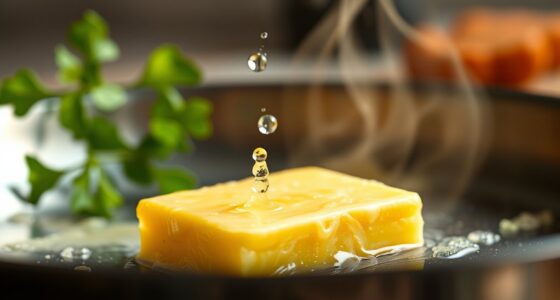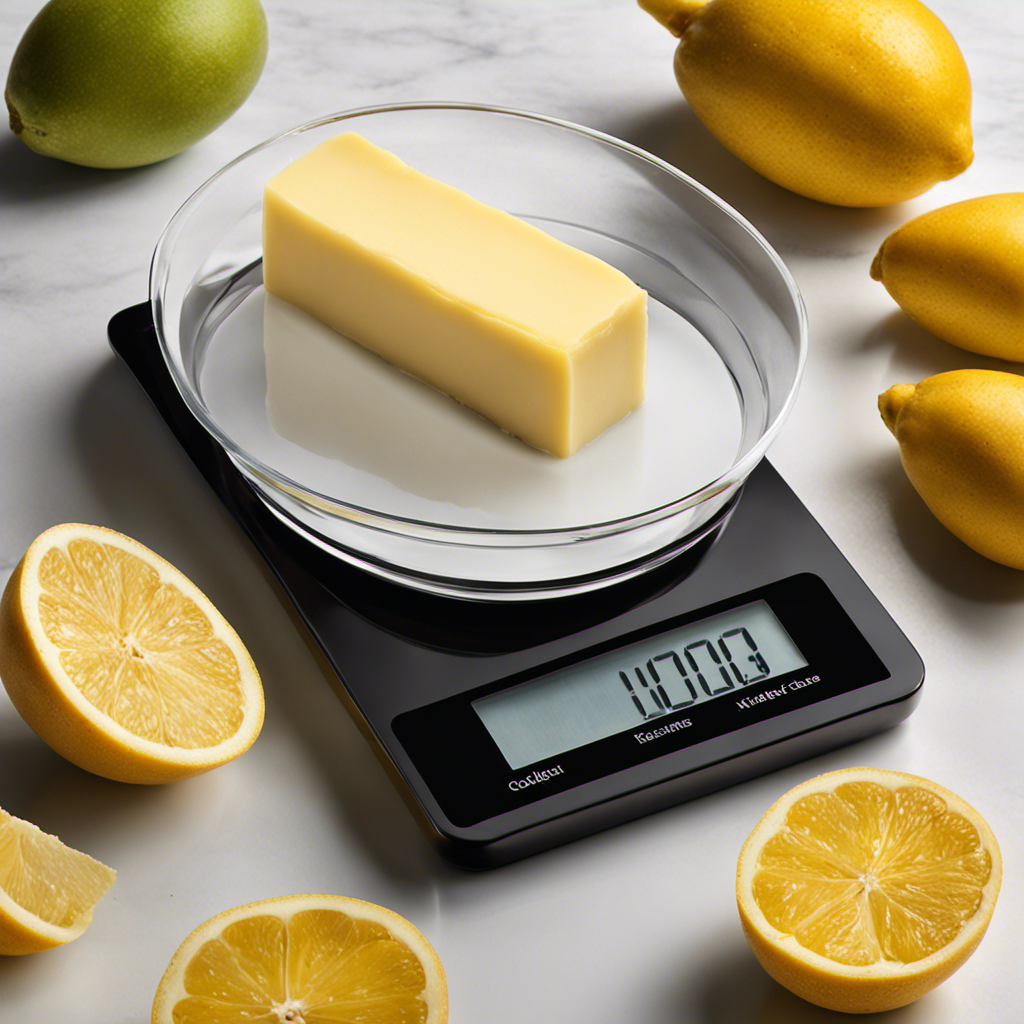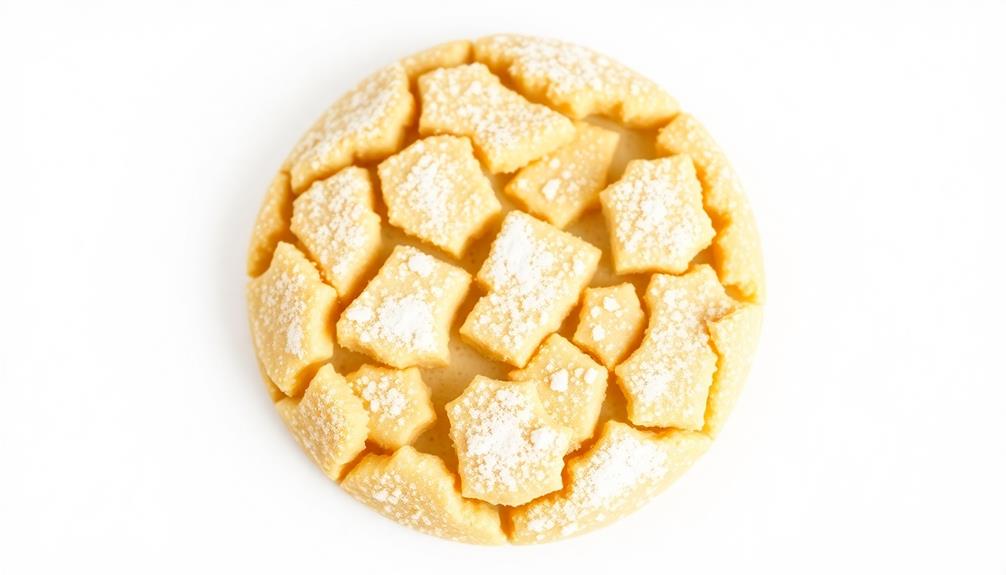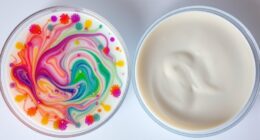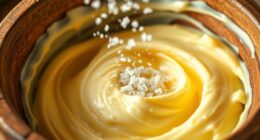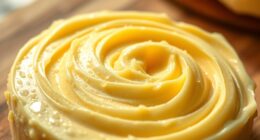Have you ever been in the midst of preparing a recipe, only to discover that you’re missing the proper measuring instruments? It’s definitely happened to me!
One common dilemma is knowing how much is 2 sticks of butter in cups. It can be frustrating, especially when you’re in a time crunch. But fear not, because in this article, I will not only explain the conversion for you, but also share some useful tips and tricks to ensure your butter measurements are always on point.
So let’s get started!
Key Takeaways
- Two sticks of butter is equivalent to 1 cup.
- Using a kitchen scale for accurate butter measurements provides precision and consistency.
- Measuring cups can lead to imprecise measurements, especially with solid ingredients like butter.
- Understanding butter measurement conversions is important for achieving accurate results in cooking and baking.
Understanding the Measurement Conversion
To understand the measurement conversion, you’ll need to know how many cups are in 2 sticks of butter. Accurate measurements are crucial in cooking and baking, as they can make or break a recipe.
When it comes to measuring butter, many people make common mistakes that can affect the final result. One mistake is not using the right measuring tool. Butter is often sold in sticks, and each stick typically equals 1/2 cup or 8 tablespoons. So, 2 sticks of butter would be equivalent to 1 cup or 16 tablespoons.
Another mistake is not properly softening the butter. It is important to bring the butter to room temperature before using it in a recipe for accurate measurements and proper incorporation into the other ingredients.
The Importance of Knowing Butter Measurements
Knowing how to accurately measure butter is important so you don’t end up with incorrect measurements in your recipes. It’s crucial to understand the different butter measurement units and how to convert them for savory dishes. Here are three key points to consider:
-
Butter comes in various forms, including sticks, tablespoons, and grams. Each measurement unit serves a specific purpose, so it’s essential to know how to convert between them.
-
When converting butter for savory dishes, it’s helpful to remember that one stick of butter is equal to 1/2 cup or 8 tablespoons. This conversion is particularly useful when following recipes that require specific amounts of butter.
-
In savory recipes, butter adds flavor and richness to dishes like sauces, sautés, and roasted meats. Accurately measuring butter ensures your dish turns out as intended, creating a delectable taste experience.
Converting Sticks of Butter to Cups: Explained
When it comes to baking, precision is key. But sometimes, the measurements can be a bit confusing. That’s why it’s important to understand butter measurement conversions, so you know exactly how much butter to use in your recipes.
Additionally, it’s crucial to question the accuracy of cup measurements, as slight variations can make a big difference in the final outcome of your baked goods.
Lastly, familiarizing yourself with common baking measurements will not only make your life easier but also ensure that your cakes, cookies, and breads turn out perfectly every time.
Butter Measurement Conversion
There’s no way to measure 2 sticks of butter in cups. But fear not, I’m here to help you understand butter ratios and convert butter measurements for international recipes.
Here are three things to keep in mind:
-
Butter ratios: Different recipes call for different ratios of butter to other ingredients. Understanding these ratios is essential to achieving the desired texture and flavor in your baked goods.
-
Converting butter measurements: When dealing with international recipes, you may come across measurements in grams or ounces instead of sticks or cups. Knowing how to convert these measurements accurately ensures that you get the right amount of butter for your recipe.
-
Handy conversion chart: To make your life easier, I’ve created a handy conversion chart that provides the equivalent measurements for sticks, cups, grams, and ounces of butter. Keep it in your kitchen for quick reference whenever you need it.
Accuracy of Cup Measurement
Measuring butter in cups can sometimes lead to inaccurate results. As a passionate baker, I’ve learned the hard way that precise measurements are crucial for successful baking. It’s not just about following a recipe; it’s about understanding the impact of accurate measurements on the final result. Let me illustrate this with a table that showcases the importance of precise measurements in baking:
| Ingredient | Accurate Measurement (grams) | Inaccurate Measurement (cups) | Result |
|---|---|---|---|
| Flour | 125 | 150 | Dense |
| Sugar | 200 | 250 | Too sweet |
| Butter | 225 | 275 | Greasy |
As you can see, even a slight variation in measurements can have a significant impact on the outcome of your baked goods. To avoid disappointment and ensure consistently delicious results, invest in a kitchen scale and use precise measurements. Your taste buds will thank you!
Common Baking Measurements
Baking can be a lot easier and more accurate when you have a kitchen scale to measure ingredients precisely. It’s especially important when it comes to understanding butter ratios and converting butter measurements in European recipes. Here are three reasons why using a kitchen scale can greatly improve your baking experience:
-
Consistency: By measuring ingredients by weight rather than volume, you can ensure that every batch turns out the same. This is particularly crucial when it comes to butter, as the amount needed can vary depending on the recipe.
-
Precision: Converting butter measurements from European recipes, which often use grams, to cups can be tricky. A kitchen scale eliminates the guesswork and gives you the exact amount needed.
-
Versatility: A kitchen scale can be used for more than just measuring butter. It’s a versatile tool that can be used for accurately measuring other ingredients like flour, sugar, and liquids.
Common Mistakes When Measuring Butter
Let’s talk about some common mistakes that people make when measuring butter.
One of the most frequent errors is converting sticks of butter to cups incorrectly. Many people assume that one stick of butter is equal to one cup, but in reality, it is only half a cup.
Another mistake that people often make is misreading the measurement markings on their measuring cups. This can lead to inaccurate measurements and affect the outcome of their recipes.
Incorrect Butter-To-Cup Conversion
If you’re using a butter-to-cup conversion, remember that 2 sticks of butter equal 1 cup. Understanding butter measurements is crucial when it comes to baking and cooking. However, there are common mistakes that people often make when measuring butter. Here are three important things to keep in mind:
-
Always remember to use the correct conversion ratio. 2 sticks of butter equal 1 cup, so make sure you’re not accidentally using the wrong measurements.
-
Pay attention to the markings on the butter wrapper. Sometimes, people misread the measurements and end up using more or less butter than required.
-
Be careful when using a scale. While weighing butter can be more accurate, it’s important to ensure that you’re converting the weight correctly to cups if the recipe calls for it.
Understanding these common mistakes will help you avoid any mishaps in your baking endeavors. Now, let’s move on to the next section about misreading measurement markings.
Misreading Measurement Markings
Pay attention to the markings on the wrapper to avoid misreading the measurements and ending up with incorrect amounts of butter. It may seem simple, but misinterpreting units can lead to disastrous baking results.
When converting butter measurements, it’s crucial to be precise. Most butter sticks in the United States are marked with tablespoon and cup measurements. However, it’s important to note that the markings on the wrapper may vary depending on the brand.
Take the time to carefully read the packaging and double-check the conversions. For example, if a stick of butter is marked with 8 tablespoons, that is equivalent to 1/2 cup.
Easy Ways to Measure 2 Sticks of Butter in Cups
You can easily measure 2 sticks of butter in cups by using a kitchen scale or a measuring cup.
Did you know that 2 sticks of butter is equivalent to 1 cup? Understanding conversions can be tricky, but when it comes to butter, it’s a straightforward process.
Measuring accurately is important for achieving the perfect consistency in your recipes.
When it comes to measuring butter, using a kitchen scale is the most accurate method. By weighing the butter, you can be sure that you have the exact amount required for your recipe.
However, if you don’t have a scale, using a measuring cup is a good alternative. Each stick of butter is typically marked with tablespoon measurements, allowing you to easily determine the amount needed.
Using a Scale for Accurate Butter Measurements
When it comes to baking, precision and accuracy are key.
While measuring cups have traditionally been the go-to tool for measuring ingredients, using a scale can provide a higher level of accuracy.
By using a scale, you can ensure that you are measuring the exact amount of each ingredient, resulting in consistent and reliable baked goods every time.
Scale Vs. Measuring Cups
Using a scale is more accurate than measuring cups for determining the amount of butter needed. When it comes to precision and accuracy in measuring butter, a scale has several benefits over a measuring cup:
-
Consistency: A scale ensures that you always use the exact amount of butter, resulting in consistent and reliable results in your recipes.
-
Versatility: Scales can measure butter in various units, such as ounces, grams, or pounds, providing flexibility for different recipes.
-
Ease of Use: With a scale, you can simply place your container on the scale, reset it to zero, and then add the desired amount of butter without the need for extra utensils or guesswork.
On the other hand, measuring cups have some disadvantages when it comes to measuring butter accurately:
-
Inaccuracy: Measuring cups can often lead to imprecise measurements, especially when dealing with solid ingredients like butter.
-
Difficulty in Measuring Solid Butter: It can be challenging to accurately measure solid butter using a measuring cup, as it requires scraping and leveling.
-
Inconsistent Results: Depending on how the butter is packed into the measuring cup, the volume can vary, leading to inconsistent results in your recipes.
With these drawbacks in mind, it’s clear that using a scale is the superior choice for precise and accurate butter measurements. It ensures that you get the perfect amount of butter every time, allowing your recipes to turn out just right.
Now let’s dive deeper into the importance of precision and accuracy in butter measurements.
Precision and Accuracy
To achieve precise and accurate measurements, it’s crucial to understand the importance of precision and accuracy in measuring ingredients. When it comes to cooking and baking, precise measurements are essential to ensure the desired outcome of a recipe.
Using the right measurement tools, such as measuring cups, spoons, and scales, can greatly improve the accuracy of your measurements. Precision is key because even small deviations can significantly impact the final result. Inaccurate measurements can lead to a dish that is too dry, too moist, or lacking in flavor.
For example, using too much or too little flour can affect the texture and structure of baked goods. So, it’s important to be mindful of precision when measuring ingredients to achieve consistent and delicious results.
Consistency in Baking
Consistency in baking is key to ensuring that your recipes turn out the same way every time. Understanding baking techniques and troubleshooting common baking mistakes are essential skills for achieving this consistency. Here are three important factors to consider:
-
Ingredient measurements: Accurate measurements are crucial in baking. Using too much or too little of an ingredient can significantly affect the outcome of your recipe. Be sure to follow the recipe’s measurements precisely.
-
Oven temperature: Temperature plays a vital role in baking. An oven that is too hot or too cold can lead to uneven baking, resulting in undercooked or overcooked treats. Invest in an oven thermometer to ensure your oven is at the correct temperature.
-
Mixing techniques: Properly mixing your ingredients can make a big difference in the texture and overall success of your baked goods. Overmixing can lead to tough and dense results, while undermixing can result in a lumpy and uneven batter.
By understanding these baking techniques and troubleshooting common baking mistakes, you can achieve consistent and delicious results every time you bake.
Now, let’s explore how to convert butter measurements for different recipes.
Converting Butter Measurements for Different Recipes
Did you know that you can easily convert the measurement of 2 sticks of butter into cups for different recipes? Understanding butter equivalents is essential in baking, as it ensures accurate measurements and consistent results.
When converting butter from grams to cups, it’s important to know that 1 stick of butter is equivalent to 1/2 cup or 113 grams. Therefore, 2 sticks of butter would be equivalent to 1 cup or 226 grams.
This conversion is handy when following recipes that use cups or grams as the measurement unit for butter. By knowing how to convert butter measurements, you can confidently adapt recipes and ensure the perfect amount of butter in your baked goods.
Tips for Successfully Substituting Butter
When you’re substituting butter in recipes, it’s important to consider the fat content and texture of the alternative ingredients. Here are some helpful tips for successfully substituting butter in your favorite recipes:
-
Avocado: Did you know that mashed avocado can be a great alternative to butter in baking? Not only does it add a rich and creamy texture, but it’s also a healthier option, packed with heart-healthy fats.
-
Coconut oil: This versatile oil is an excellent choice for vegan recipes. Its high fat content and mild flavor make it a suitable replacement for butter in various baking recipes. Just make sure to use the same amount as the butter called for in the recipe.
-
Nut butters: Almond, cashew, or peanut butter can add a delicious nutty flavor to your baked goods. These spreads are packed with healthy fats and can be used as a 1:1 replacement for butter in most recipes.
Adjusting Butter Measurements for Different Brands
To accurately adjust butter measurements for different brands, you’ll need to take into account the fat content and packaging size. Adjusting butter measurements is crucial when it comes to baking, as the quality of butter can greatly impact the outcome of your baked goods. Different recipes may call for different amounts of butter, and using the wrong measurement can throw off the entire recipe. To help you navigate this, I’ve created a table below that outlines the fat content and packaging size for various butter brands commonly found in stores. By knowing this information, you can make the necessary adjustments to ensure your recipe turns out perfectly every time. Now, let’s move on to the next section where we will discuss converting sticks of butter to cups using a handy chart.
| Butter Brand | Fat Content (%) | Packaging Size (oz) |
|---|---|---|
| Brand A | 80 | 16 |
| Brand B | 82 | 8 |
| Brand C | 79 | 32 |
| Brand D | 85 | 4 |
| Brand E | 78 | 12 |
Now that you have a better understanding of the fat content and packaging size for different brands of butter, let’s move on to converting sticks of butter to cups using a handy chart.
Converting Sticks of Butter to Cups: A Handy Chart
Now that we have covered adjusting butter measurements for different brands, let’s take a look at a handy chart for converting sticks of butter to cups. Converting butter measurements is essential, especially for those following vegan recipes or looking for alternatives. Here’s a handy chart to make your life easier:
- 1 stick of butter = 1/2 cup
- 2 sticks of butter = 1 cup
- 4 sticks of butter = 2 cups
When it comes to accurate measurements, storing butter properly is crucial. The best way to store butter is to keep it in the refrigerator, tightly wrapped in its original packaging or in an airtight container. This will help maintain its freshness and prevent any unwanted odors from seeping in.
Now that we have covered converting sticks of butter to cups, let’s explore other butter measurement conversions and discover more helpful tips for your baking adventures.
Exploring Other Butter Measurement Conversions
Exploring other butter measurement conversions can be helpful for those who want to experiment with different recipes. When it comes to measuring butter accurately, it’s not always as simple as using just cups or sticks. Converting butter for international recipes can be a bit more challenging, as different countries have different butter measurements. To make things easier, I’ve created a handy conversion chart:
| Butter Measurement | Equivalent |
|---|---|
| 1 stick of butter | 1/2 cup |
| 1/4 cup of butter | 1/2 stick |
| 1 cup of butter | 2 sticks |
Frequently Asked Questions
Can I Use Margarine Instead of Butter When Measuring 2 Sticks in Cups?
Using margarine instead of butter can alter the texture and flavor of baked goods. Butter provides a rich and creamy taste, while margarine may produce a slightly different result. It’s best to follow the recipe’s recommendation for optimal results.
How Many Tablespoons Are in 2 Sticks of Butter?
Converting sticks of butter to tablespoons can be a tricky task. Luckily, I’ve mastered the art. As for measuring butter without sticks, I’ve got a few tricks up my sleeve. Let me enlighten you.
What Is the Weight of 2 Sticks of Butter in Grams?
To convert 2 sticks of butter to cups, you need to know the conversion rate for salted and unsalted butter. Additionally, it’s interesting to compare the weight of 2 sticks of butter to other common kitchen ingredients.
Can I Use a Different Fat, Like Oil, Instead of Butter When Measuring 2 Sticks in Cups?
Can I use coconut oil instead of butter when measuring 2 sticks in cups? What are the health benefits of using olive oil instead? Let’s explore these alternative options and their impact on your recipe.
Do I Need to Soften the Butter Before Measuring It Into Cups?
I always soften the butter before measuring it into cups. It makes it easier to work with and ensures accurate measurements. As for using salted butter instead of unsalted, it’s a matter of personal preference.
Conclusion
In conclusion, understanding butter measurements is essential in the kitchen. Converting 2 sticks of butter to cups is a straightforward process that can be easily done using a handy chart.
However, it’s important to be mindful of common mistakes when measuring butter and to adjust measurements for different brands.
By knowing these tips and tricks, you can confidently substitute butter in your recipes. So, next time you’re baking, remember that knowledge is like butter – it spreads and enhances the flavor of your culinary creations.


